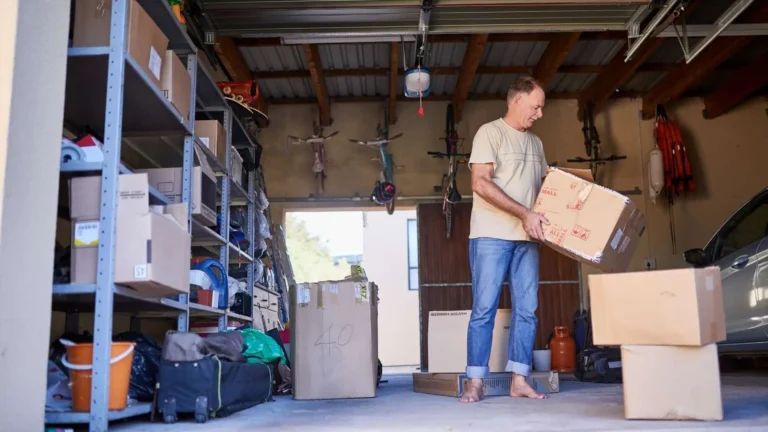Table of Contents
In every city across America, the storage market is booming. People downsize, move across states, or run out of room in their homes, creating a huge demand for safe, flexible storage. For property owners with a spare garage, basement, or extra room, this trend has opened up an overlooked income stream: renting out storage space.
However, while it sounds simple -“just let someone put boxes in my garage for a fee”-the reality involves legal contracts, liability concerns, and sophisticated pricing models. Done right, storage rentals can be a steady side hustle. Done incorrectly, they can escalate into disputes, damage property, or even lead to lawsuits.
This guide explores the legal basics, the right way to set rates, and strategies to maximize earnings without unnecessary risks.
Why Storage Rentals Are in High Demand
The rise of minimalism, urban living, and e-commerce has fueled America’s storage craze. But it’s not just clutter that drives people to rent space.
- Life transitions, such as divorce, military deployment, or starting college, often create temporary storage needs.
- Small business overflow: Entrepreneurs and online sellers often require additional storage space for inventory without incurring warehouse rates.
- Seasonal use: People store boats, bikes, skis, or holiday decorations for part of the year.
- Rising costs: Self-storage facilities are expensive, with average rates ranging from $100 to $200 per month for mid-sized units. Peer-to-peer rentals offer more affordable and local alternatives.
For side hustlers, this demand creates an opportunity to monetize unused square footage, often with minimal effort once the necessary systems are in place.
Read related blog: Personal Loans for Legal Fees
The Legal Ground Rules You Can’t Skip
Renting storage space is not as casual as letting a friend keep boxes in your shed. Legally, you are entering into a landlord–tenant–style arrangement, and skipping paperwork can expose you to big risks.
1. Written Agreements Are Essential
A handshake won’t cut it. You need a simple written contract that defines:
- What can and cannot be stored (no hazardous materials, flammables, or illegal goods).
- Access rules (including hours, notice requirements, and whether the renter is provided with a key).
- Payment terms (monthly, upfront, late fees).
- Liability clauses (what happens if items are damaged, stolen, or destroyed).
2. Liability and Insurance
Property owners are typically not responsible for damage caused by floods, fires, or theft if the contract clearly states otherwise. Encourage renters to carry renters’ or business insurance for their goods. Some peer-to-peer platforms even provide insurance coverage.
3. Local Laws and Zoning
Not every basement can legally double as a storage business. Some cities require permits or restrict commercial activity in residential areas. Research your local zoning rules before you post your ad.
4. Eviction Rights for Nonpayment
If someone stops paying, you can’t just throw their belongings on the curb. Each state has laws governing the handling of abandoned property, often requiring notice periods or small claims filings. A good contract includes these terms upfront.
Legal clarity isn’t just protection for you. It also builds trust with renters who want to know their belongings are handled professionally.
Read related blog: Homebuying for Single Adults: Is Renting Better?
Deciding What Kind of Space to Rent
Not every square foot is created equal when it comes to storage. The type of space you offer determines who your renters will be, how much you can charge, and how quickly it will be filled.
- Garages and Driveways: These are in high demand among vehicle owners, motorcycle enthusiasts, and individuals with trailers and boats. In dense cities or snowy states, vehicle storage can command premium rates because it saves renters from costly parking tickets or seasonal damage. If you’re offering a driveway spot, be clear about weather exposure and security measures in place.
- Basements and Spare Rooms: These spaces often attract families in transition, such as those who are between homes, downsizing, or storing seasonal items like holiday decorations. A finished, dry basement can also appeal to small business owners who need storage space for products such as books or clothing. Moisture control is critical here; investing in a dehumidifier can allow you to charge more.
- Closets and Attics: Although smaller, these spaces are valuable to renters seeking safe, climate-stable storage for clothes, collectibles, or documents. Because they’re less accessible, they often suit long-term storage where frequent access isn’t required.
- Outdoor Sheds: Ideal for hobbyists and DIY enthusiasts who store bikes, tools, or gardening equipment. These spaces become especially popular in the spring and summer when people dust off their sports gear and outdoor equipment.
Pro tip: Take inventory of your space’s strengths. A climate-controlled basement can be marketed as “safe for electronics or furniture,” while a garage with lockable doors appeals to car enthusiasts.
How to Price Storage Space Fairly
Pricing can be tricky. Too high, and renters will choose professional facilities. Too low, and you’ll undervalue your property. Here’s how to set smart rates:
1. Research Local Self-Storage Rates: Check nearby storage facilities and peer-to-peer apps, such as Neighbor.com or Stashbee. If a 10×10 unit goes for $120/month, you might offer $80–$100 for a comparable home-based option.
2. Consider Access and Amenities: Spaces with 24/7 access, climate control, or extra security can command higher fees. Limited access (like “only weekends” or “must call ahead”) justifies lower prices.
3. Offer Flexible Packages
- Flat monthly rate: The simplest, most common option.
- Weekly pricing: Useful for short-term movers or students.
- Tiered pricing: Higher rates for vehicle storage compared to boxes or small goods.
- Premium add-ons: Offer pickup/drop-off service for an extra fee.
4. Build in Deposits and Late Fees: A refundable security deposit covers damages or overstays. Late fees discourage missed payments. Transparency is key to avoiding awkward disputes.
Read related blog: Affidavit of Title Explained: Legal Property Documentation
Comparing Storage Income Potential
Here’s a quick snapshot of what different spaces can earn:
| Space Type | Typical Monthly Rate | Best Use Case | Notes on Income Potential |
| Garage (1 car) | $80–$150 | Vehicles, tools, bikes | Higher in cities/seasonal |
| Basement (10×10) | $60–$120 | Furniture, electronics, boxes | Add value if climate-controlled |
| Spare Room | $50–$100 | Clothes, collectibles, books | Limited access = lower price |
| Outdoor Shed | $40–$80 | Sports gear, tools, and garden | Demand rises in spring/summer |
Even a single garage or basement can quietly generate $ 1,000 or more per year, often with minimal effort once renters are established.
Keeping Things Secure and Professional
When someone entrusts you with their belongings, professionalism matters as much as price. Security and transparency can make or break your reputation.
- Invest in Locks and Access Control: A sturdy deadbolt, coded lock, or even a smart lock shows renters that you’re serious about protecting their items. If you’re renting a shared space, consider providing renters with their own locked section (such as a cage or cabinet) for added peace of mind.
- Document Everything: Take photos of the storage space before move-in and create a simple inventory list with the renter. This avoids disputes later about damage or missing items. Some storage landlords even provide checklists that renters sign.
- Decide on Access Rules Upfront: Will the renter have a key to come and go freely, or will they need to schedule visits with you in advance? Free access can attract more clients, but supervised access adds a layer of security. Choose what works best for your comfort level.
- Professional Communication: Send receipts for payments, set clear renewal reminders, and use written communication for major changes. Even if you’re just one person renting a garage, acting professionally builds credibility and helps you charge higher rates.
Read related blog: Tax Implications of Renting vs Owning in 2025
The Hidden Costs of Renting Storage Space
At first glance, renting storage appears to be a “pure profit” venture. After all, you’re just using space you already own. But there are hidden costs that can cut into earnings if you’re not prepared.
- Insurance Adjustments: Some homeowner insurance policies increase premiums if you’re running a business from your property. Others may exclude coverage entirely for stored goods. Be sure to clarify what is (and isn’t) covered.
- Utilities: If your renter requires climate control, such as for furniture, electronics, or collectibles, expect higher electric bills due to the use of dehumidifiers, fans, or heaters. This cost should be factored into your pricing.
- Wear and Tear: Heavy furniture scraping floors, boxes leaving marks on walls, or people frequently coming in and out of your property can lead to repair costs over time. Small deposits often cover these risks.
- Time Costs: Coordinating schedules, answering questions, or handling disputes eats into your time. If you don’t value your time realistically, you’ll find the earnings aren’t worth the hassle.
By planning for these costs, you avoid the shock of realizing your “$100/month” rental is only netting $50 after all expenses are accounted for.
Avoiding Common Mistakes in the Storage Game
Many beginners jump into storage rentals thinking it’s effortless. In reality, small mistakes can turn into costly problems.
- Allowing Prohibited Items: Without clear rules, renters might store gas cans, chemicals, or even illegal goods. This creates liability risks for you. A written agreement should always prohibit the use of hazardous or unlawful materials.
- Skipping Deposits: Deposits aren’t just about damage; they also discourage renters from abandoning property without notice. A simple $50–$100 deposit can prevent bigger losses later.
- Ignoring Local Rules or HOA Restrictions: Some neighborhoods or associations ban commercial use of property. Renting space without checking can lead to fines or forced shutdowns.
- Poor Communication: Failing to clarify terms promptly or ghosting renters erodes trust. Even if it’s a side hustle, treating it like a business ensures smoother operations.
- Pricing Without Research: Charging too little undervalues your space, while charging too much drives renters away. Pricing should reflect your location, size, and security, not just guesswork.
These pitfalls are easy to avoid with a little preparation and professionalism, ensuring your storage side hustle becomes an asset, not a liability.
Read related blog: Psychology Behind Car Insurance Pricing: What Insurers Don’t Always Tell You
Seasonal Demand Patterns for Storage Rentals
Here’s a table that shows when demand tends to spike, helping you time your listings and adjust pricing:
| Season | Common Storage Needs | Peak Demand Triggers | Smart Pricing Tip |
| Spring | Sports gear, gardening tools, decluttering projects | Spring cleaning, home moves | Offer discounts for multi-month rentals |
| Summer | College student storage, boats, camping gear | Students leaving campus, vacationers | Charge higher for short-term contracts |
| Fall | Business inventory, school supplies, seasonal decor | Small business ramp-ups, Halloween/Thanksgiving storage | Bundle space for small businesses |
| Winter | Holiday decor, cars, snow gear | Holiday overflow, vehicle storage in snowy states | Add a premium for climate-controlled or covered spaces |
By aligning your availability and promotions with these seasonal cycles, you can fill your space more quickly and maximize your income throughout the year.
How Beem Can Help You Scale Your Storage Hustle
Sometimes the barrier to turning an empty garage into a money-maker is small costs: $50 for a better lock, $30 for security cameras, or $25 for legal contract templates. That’s where Beem’s Everdraft™ Instant Cash makes the difference.
With instant access to up to $1,000 (no interest, no credit checks), you can handle small investments without pausing your side hustle. Pair that with Beem’s FDIC-insured wallet, cashback on essentials like hardware store purchases, and smart financial tools, and you’ve got a partner who helps you scale.
Whether you’re converting one spare room or managing multiple rental spaces, Beem helps you stay ready, secure, and profitable.
FAQs on Renting Storage Space: Legal Basics and Pricing
Do I need a business license to rent out storage space?
In many areas, casual rentals don’t require a business license, but some cities or HOAs do regulate home-based businesses. Always check your local laws so you avoid fines or conflicts later.
Can renters store anything they want in my space?
No, you should always set clear rules that prohibit hazardous, illegal, or perishable items. Having a written agreement provides protection and ensures your property remains safe.
How much can I realistically earn from storage rentals?
Earnings vary widely depending on the type of space and location. Garages often fetch $100–$200/month, while closets may earn $30–$60. Consistency matters more than one big payout, so aim for steady occupancy.
Is insurance necessary for a small storage side hustle?
Yes, both you and your renters benefit from having coverage, even if it’s a simple rider on your homeowner’s policy. Without it, a single loss or dispute could wipe out your profits.
What’s the best way to attract renters quickly?
List your space on local platforms, such as Neighbor, Facebook Marketplace, or Craigslist, with clear photos and detailed descriptions. Fast responses to inquiries can often be the deciding factor in securing a renter.
Turning Empty Space Into Steady Income
Renting out storage isn’t glamorous, but it’s one of the most straightforward ways to monetize what you already have. With a little legal prep, fair pricing, and smart security, your garage or basement can transform from wasted square footage into a reliable income stream.
And when small setup costs threaten to stall you, Beem ensures you never miss an opportunity to turn space into a steady cash flow. In the storage game, the difference between clutter and cash is simply a well-planned approach. Download the app now!















































